
Enthusiastic as I am about travelling, I do wonder sometimes whether the whole process of trying to leave England’s green and pleasant shores for something greener on the other side, as it were, is worth the trouble.
I practically abandoned all hope early on in the process of trying to get to Spain. Having booked with one of our cheaper airlines (big mistake), only for the flight to be cancelled, and then gone through the nightmarish process of changing flights online, then having to alter the whole trip because there was a connection to a different airline, and a hotel booked at the destination that also needed to be cancelled, I think I can be forgiven for wishing that life was not so ‘interesting’ – in the meaning of that old Chinese curse: ‘may your life be interesting’. Sigh.
Having managed all the above without throwing my laptop through the window the great travelling day arrives. It is early, it is raining and I am half asleep. The terminal building swarms with travellers. I have already checked in. A fairly pointless procedure because one still has to queue to drop off one’s bag. The whole experience is one of humiliation. I endure the now normal security checks: take off belt, take off shoes, take off jacket, take off watch, shove liquids into plastic bag, take out electronic gizmos, empty pockets. The alarm goes off when I go through the body scanner. I put my hands up. Someone swipes a metal detector all over me. I have endeavoured to make the sojourn at the airport easier by paying for priority boarding to miss the queues, only to find that half of the passengers have done the same. I join a long queue. I file through the boarding pass inspection, and shuffle through the corridor and down the stairs and someone treads on my heels, and a tot picks this perfect moment for a tantrum, and I find there is no room for my cabin bag in the overhead locker so end up placing it some distance away from my seat. And I flop down into said seat to find someone telling me it’s her seat because I misread seat ‘C’ as the window seat and not the aisle… And I am totally frazzled and vow never to travel anywhere ever again.
But Madrid is bathed in golden sunlight. The taxi I booked has turned up and the mood is a whole lot sunnier. I have booked a five day tour from Madrid to the region of Andalucía, taking in Caceres, Seville, Granada, the Costa del Sol and Toledo with a couple of days at the end back in the capital to while away at will.

It is day one of the tour and I am supposed to turn up at the tour company office in Madrid at 0745. I had done a recce the night before, and it is only a fifteen minute walk from my ‘hotel pension’, in which there are ensuite rooms only. No breakfast. I leave when it is still dark and trundle my case down a narrow street and nip into a café for a coffee, calculating that I have plenty of time. Good decision. I cross the Plaza España and turn right up the hill, noting the Egyptian temple of Dehob opposite as dawn breaks. When I arrive at the office it is in darkness. I am too early and stand outside the door as a few other ghostly figures drift towards it. We are let in at 0800.
Many people are going on a day trip to Toledo and the three employees that have eventually turned up sit behind a long desk, taking their tickets. At 0830, patience at an end, I venture to enquire where our guide is, having been here, as requested, since well before 0745. A few hasty phone calls, and ten minutes later a flustered Spanish speaking guide turns up. The coach has been delayed due to traffic, we gather. Someone in the office could have informed us of this beforehand, I suppose. The guide speaks very little English, although the tour is advertised as operating in English and Spanish. This does not augur well.
There are only two of us English speakers joining a coach full of Spaniards, myself and an Australian lady. The commentary is in Spanish with a few random interjections in English. My ‘O’ level Spanish taken at school about fifty years ago does not help much. Thus the first few hours of the tour towards Cacares passes in a blur of rapid Spanish. The scenery is pleasant enough though. We are in the region of Extremadura in west central Spain. Rather hilly and greenish. I understand that one of the conquistadors, Francisco Pizarro, who conquered Peru, was born in the hill top town of Trujillo, which we see high in the distance within its castle walls; I gather that most of the trees we are seeing are olives and oaks, and that the river we glimpse at various points is the Tagus/Tajo, the longest river on the Iberian peninsula, which runs into the Atlantic at Lisbon.
Cacares
On arrival at Cacares we two English speakers tour this UNESCO world heritage site on our own with a map, while the Spanish contingent have a guided tour. The guide is very apologetic. Not her fault. Just the tour company trying to save money ‒ I am supposing ‒ by bunging in the couple of English speakers with the Spanish group for most of the day. They won’t mind, will they….
Cacares is a medieval town with its surrounding walls and towers intact. Few signs of modernity here. It is full of old churches, hermitages, convents and palaces made of old brown stone with pointed or round arches and gates, and narrow cobbled streets. Built with the wealth from the American colonies. I enter the Church of San Francisco Javier perched high on one side of the Plaza de San Jorge. It is baroque and has a round arch over the portico which is flanked by two white towers. Lovely view over the square. Inside are bright white walls contrasting with a magnificent altar of gold leaf. Outside there is a statue of Saint George on his horse killing the dragon.
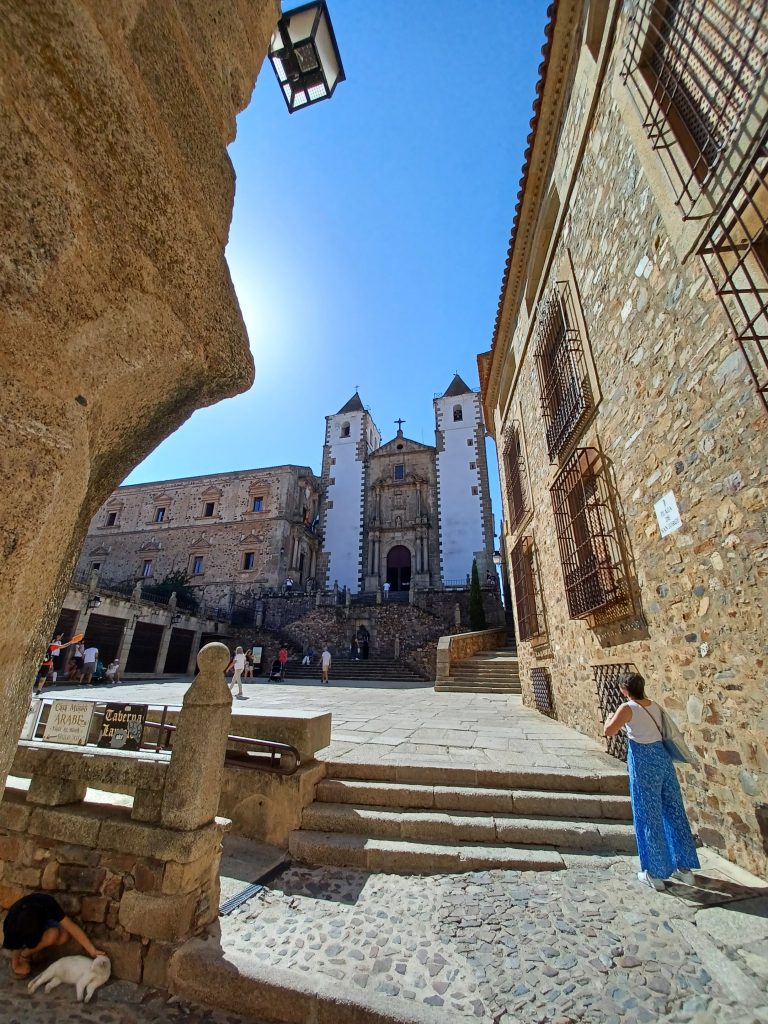
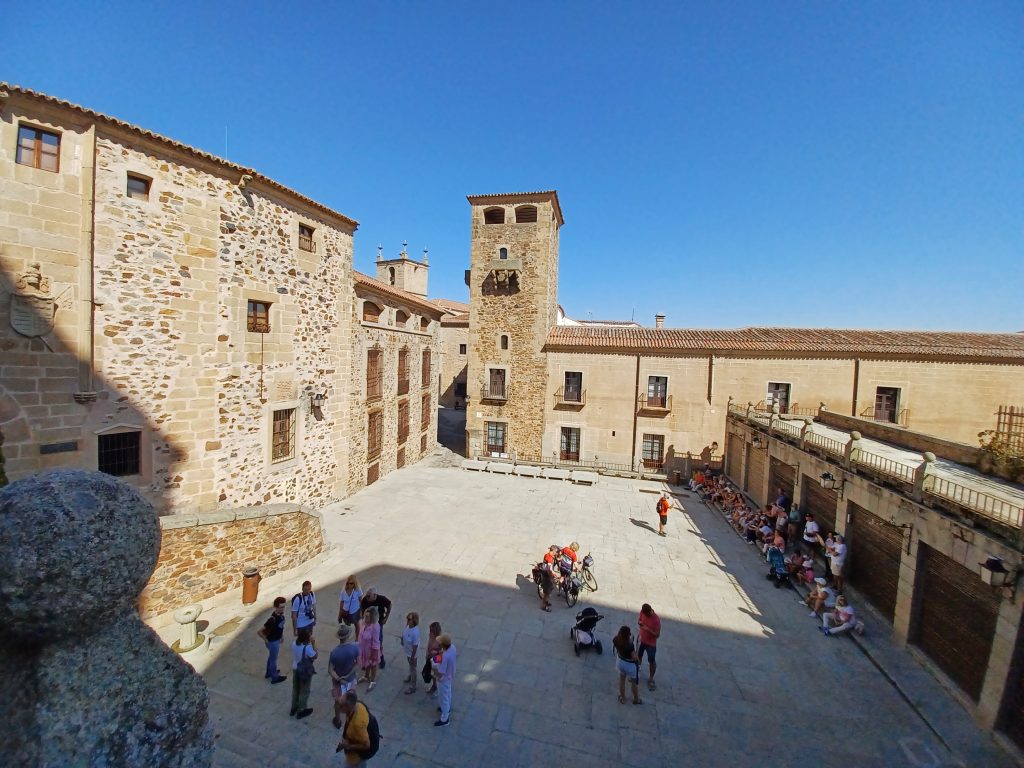
It is hot. I did not expect temperatures to be well over 30 degrees in October. After wandering round a bit, an enticing restaurant hoves into view and we lunch al fresco amidst a few pot plants. We overlook the green hills. The menu has a choice of classic Extremaduran dishes. I choose bacalao ‒ salted cod. Much of the cod served in Spanish restaurants comes from Iceland. I know that because cod is one of Iceland’s exports to the Iberian peninsula. Anyway, it is jolly good. Especially washed down with red wine. The day is getting rosier, although we have no time to sample the dessert as it is time to hurry back to the departure point.
We change to a different coach here, which is full of French Canadians, who have been touring for well over a week together. They are clearly having a good time and the background ambience is anything but peaceful. Two ladies seem to be competing with each other as to who can cackle the loudest and longest while a man in a monotone constantly cracks jokes. Opposite, an elderly gent sips from a full wine glass. Perhaps that helps blot out the noise. The coach itself is very cramped and the two seats side by side, which have been left vacant, have barely enough room for one’s knees. No doubt this is why they are vacant. I sit hunched up by the window, my torso facing to the front and my legs at 45 degrees. Someone is coughing and sneezing all over the place behind me and someone else is coughing and sneezing all over the place across the aisle. I am hot. The air conditioning is fitful. There are many miles to cover between Cacares and Seville. I wonder vaguely if I am in hell.
The guide, however, provides information in English and French in equal proportions. He is slow speaking and clear. Good. After one stop for rest rooms and coffee – don’t bother about the tea as, if it is available at all, there is no milk, and if you are English you usually prefer milk in your tea – I move to the back of the coach and take a seat between the French Canadians’ spare bags and baggage. At least my legs can spread out and I can focus on things other than discomfort. As we pass through a scrubby landscape dotted with olive trees, I hear through the guide’s microphone that Seville is full of orange trees, 40,000 of them, mostly of the sour variety which, as well as much needed shade, “provide fruit for the Englishman’s marmalade.”
Seville
As Seville approaches, we see the Guadalquivir river, the only navigable waterway in Spain, we are told, accounting for Seville’s importance as an inland port city. Our large hotel, the Silken Al Andalus Palace, is outside the centre near a football stadium, which hosts the Real Betis football club. This seems to be the usual practice with large tour groups – to be accommodated outside the centre I mean.
As we disembark, with many travellers milling about, I discover there are at least three tours in this area going on right now run by the same company. They contain a variety of different language speakers, coming and going from/to different destinations but converging in certain places. All the groups have one or two nights in Al Andalus Palace. The buffet (included in the price) is jolly good and the wine (excluded from the price) is also jolly good. I am not sure what it is because I order by the glass. Probably some cheap table wine but it goes down well after a challenging day.
Seville is wonderful. Shame we only have one full day, and full it is. Starting at 0830 and we pick up a local guide, who is responsible for the English speaking group. Hoorah. Oh, and the French speaking group also. A lady with gingerish curls, she oozes enthusiasm as she switches between the two languages pointing out the highlights as we wander round the city. This is tricky as we navigate very narrow streets with hordes of other tour groups.
Plaza España
First stop, however, is the stunning and grand Plaza España, situated in a corner of Maria Luisa park, and which is big enough for multitudes. The buildings, made of brick and ceramic tiles, were constructed for the Ibero-American expo of 1929 in a horseshoe shape with a tower at each end around a horseshoe shaped ‘square’ and horseshoe shaped canal crossed by four bridges. “The bridges represent the four ancient kingdoms of Spain: Leon, Navarre, Castile and Aragon”, our guide tells us. The buildings are decorated with arches and columns, ceramic tiles, ceramic balustrades and lamps.
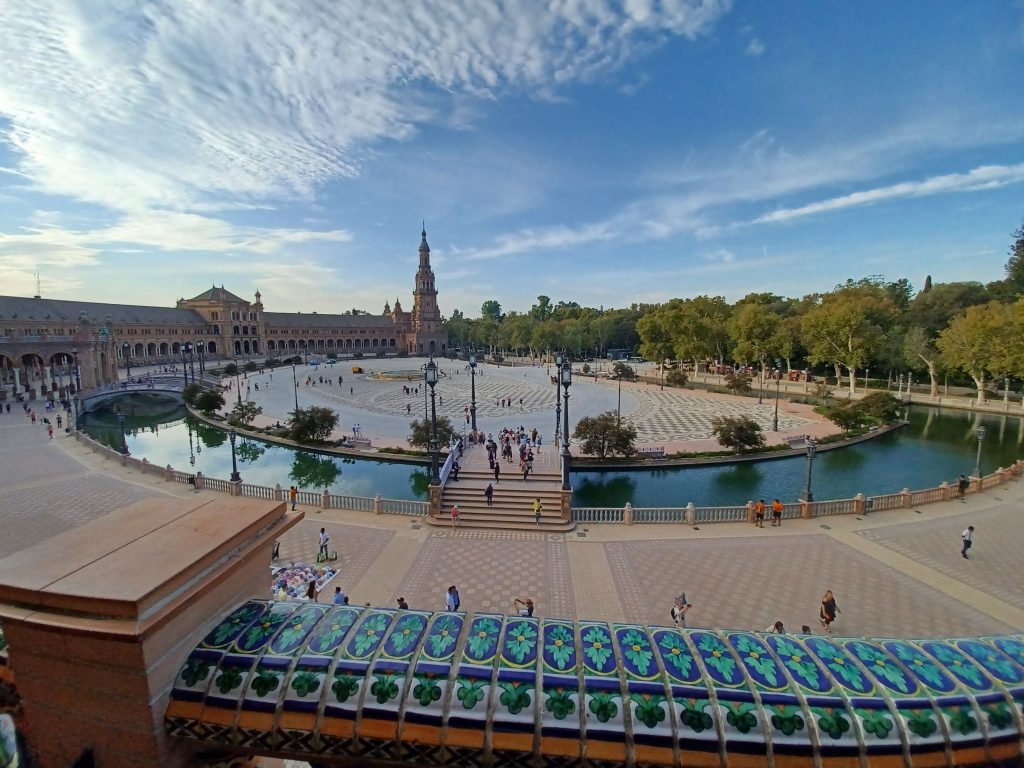
Along the base of the buildings are colourful tiled alcoves, which characterise 49 of the 50 provinces of Spain excluding Seville itself. Each depicts a historical aspect of the province along with a map of the area. The one of ‘Ciudad Real,’ (Royal City) located in Castile – La Mancha, depicts the fictional knight errant, Don Quixote, in Miguel de Cervantes’ novel, on his horse with Sancho Panza by his side on his donkey on a hillside with windmills. That of Madrid shows Napoleon’s forces storming the city. Our guide tells us the tiles were made using clay from the Guadalquivir’s banks and that ‘Guadalquivir’ means large river in Arabic. OK.
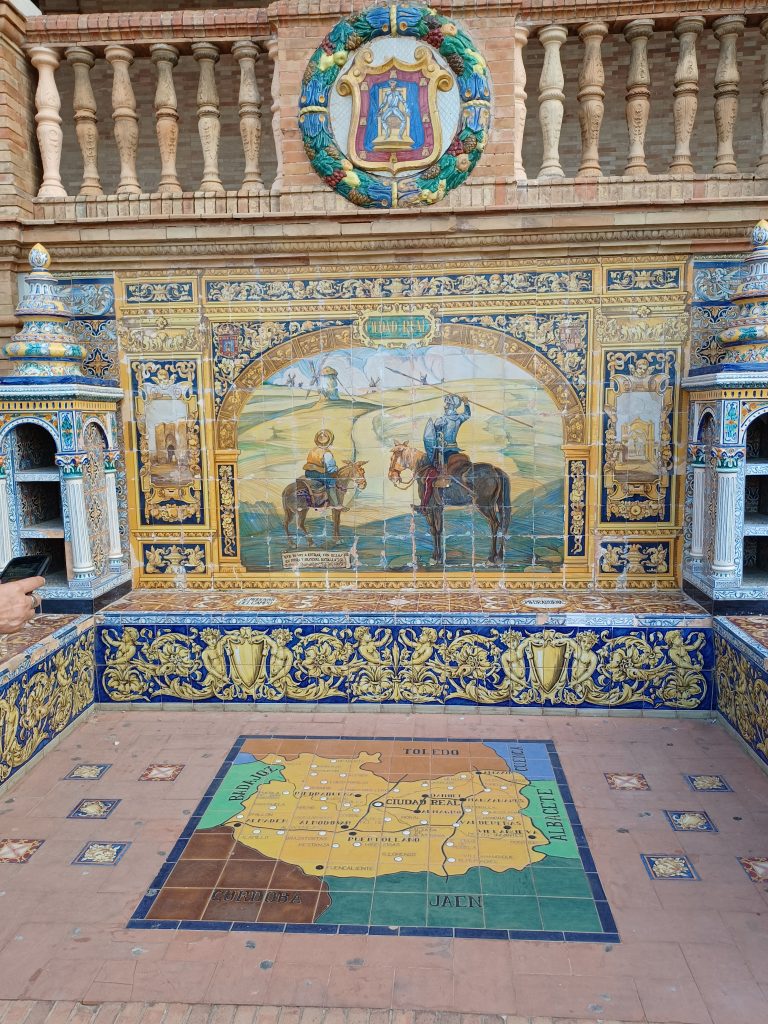
In the centre of the square is a fountain and, on one section of canal, rowing boats are lined up ready for hirers. Opposite is an area of trees under which horses and carriages with bright yellow wheel hubs and spokes await trade in the shade. One or two horses, pulling their carriages with happy travellers, trot round the square, while Spanish traders play castanets to attract tourists to buy their wares, which are laid out on the cobbles: fans with pictures of flamenco dancers on them, mantillas and shawls. “Hola! Buenos dias! You want to buy a fan?” Cameras happily snap. Inside, I walk up some grand stairs to the second floor of a tower to take in the view. A chap is playing some kind of wind instrument half way up. I slow down my ascent to listen to him. Rather lovely.
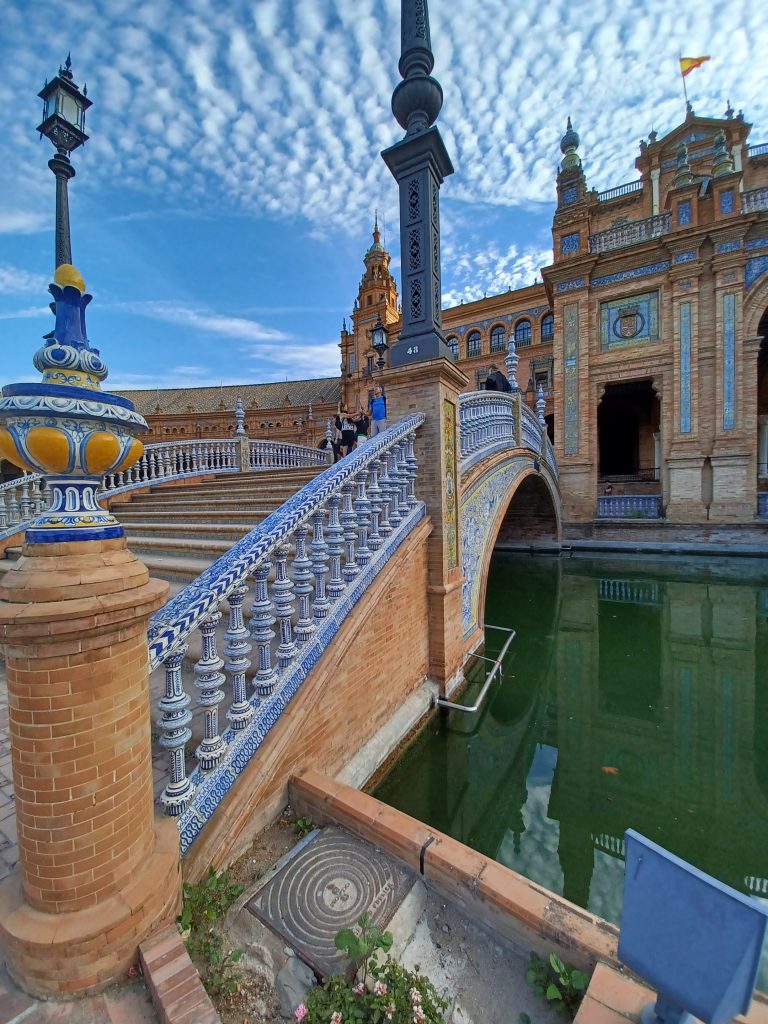
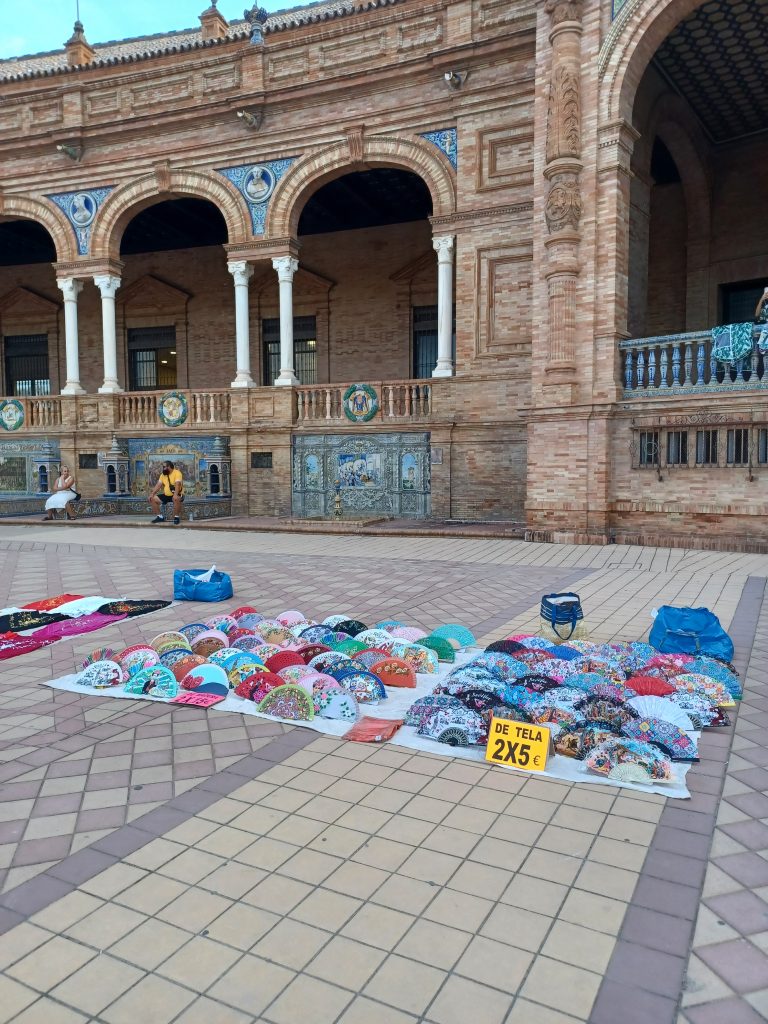
We hop back on the bus to drive round the edge of Maria Luisa park, along which are lavish pavilions built for the exposition. These buildings each epitomise the countries of North, South and Central America. After the expo they were supposed to be used for their embassies or consulates but some of them are now part of the University of Seville, or the Dance Conservatory or municipal buildings of some sort. The Latin American pavilions have some delightful decorations on their facades: that of Guatemala is covered with blue and white tiles and two large green quetzals, the country’s national bird. Maria Luisa park itself is extensive. Tantalising glimpses of pools and tree shaded paths are seen from the coach. Good to have a large green park as, my Australian friend tells me, Seville’s air quality is poor today. The lungs of Seville should help us breathe more easily.
One of the more interesting buildings we pass is the Royal Tobacco Factory, which was built in order to make snuff, and then cigars and cigarettes, from the tobacco grown in Spain’s colonies in the Americas. “This is where Carmen worked as a cigarette maker”, says our guide. “The passionate leading lady in Bizet’s opera”. Some chap starts whistling the opening bars to the Habanera, Carmen’s entrance aria. Quite diverting.
The walking tour resumes in the Jewish quarter of medieval Seville. The Jews –along with the Moors – were expelled in the fifteenth century, we are told. We find ourselves in higgledy-piggledy streets and squares with fountains and ceramic benches and orange trees. Cafés and artisans’ shops are everywhere. A lady scoops chocolate sunflower seeds into the hands of willing travellers, in the vain hope that some will enter her shop.
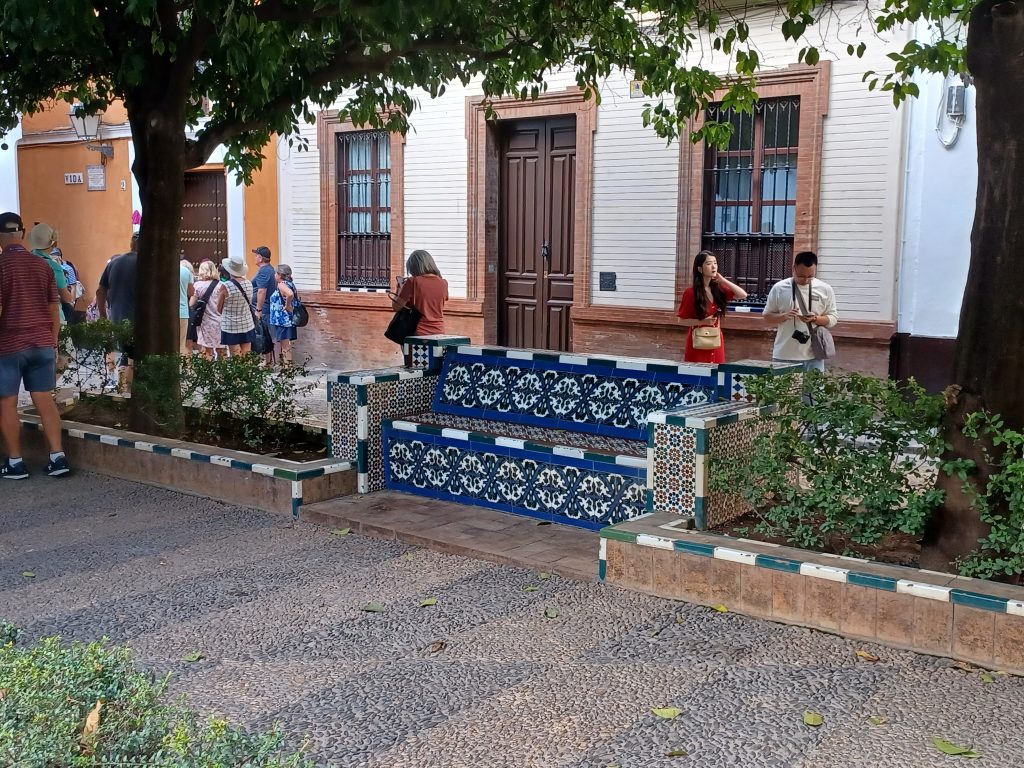
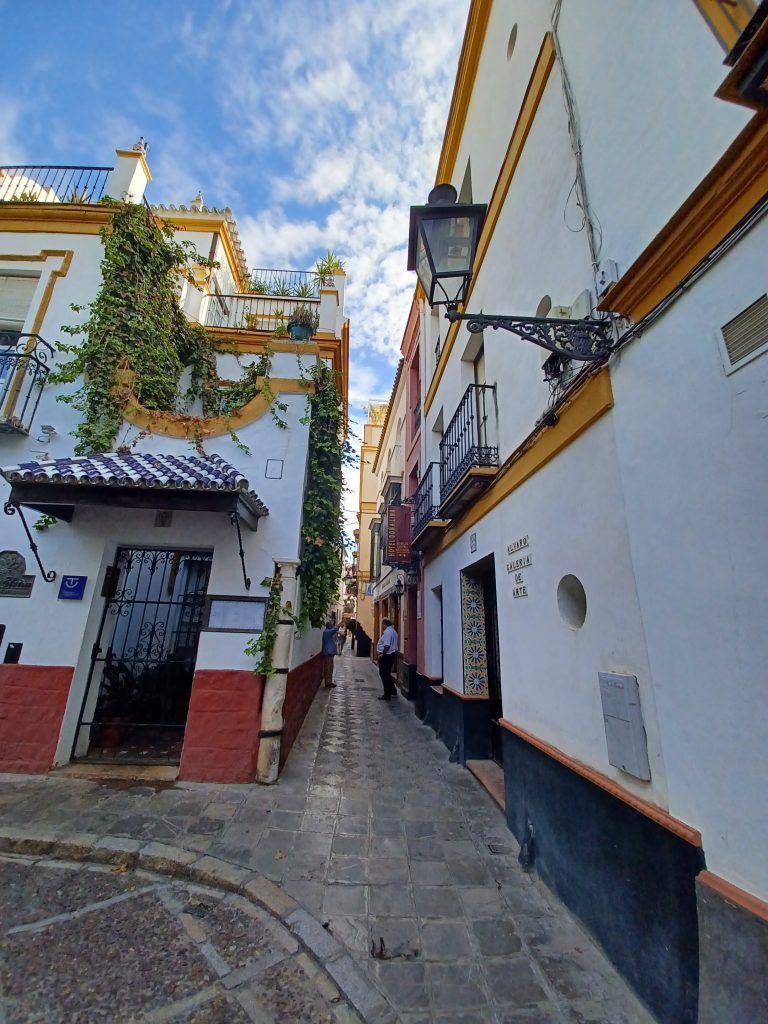
We are herded outside a mansion, once the Hospital de los Venerables Sacerdotes, a hospice for old clergy, in the square of the same name. The guide tries to talk – with minimal success ‒ above the noise of many tour groups. Talk about the madding crowd. We follow the fan, a bright red one, which she holds aloft, down a narrow street. It can’t be more than three feet wide.
In another square in the Jewish quarter, there are many elaborate metal grilles over the lower windows and doors. “These metal grilles were put there for security so that the inhabitants could open them [the windows] on hot nights”, our guide informs us. She continues: “This kind of metalwork is one of the crafts here in Seville, along with ceramics.” A guitarist serenades the throng as we come out of a passage into a pretty square, where people are queuing for tickets for the Alcazar, the fortress from which the Moors ruled, now a royal palace. We are told that we could be hours in the queue and still might not get tickets. That’s that then. Anyway, free time is limited.
We leave behind the Alcazar’s tall stone wall with its towers and crenellations and head to a restaurant for a three course lunch – with wine. After stoking up on sizeable and unnecessary portions of foodstuffs, there are less than three hours to explore alone before the coach heads back to the hotel. I would like to do a river trip on the Guadalquivir, usually my first choice when water is close by, but the Cathedral wins out on this occasion. A must see.
Seville Cathedral
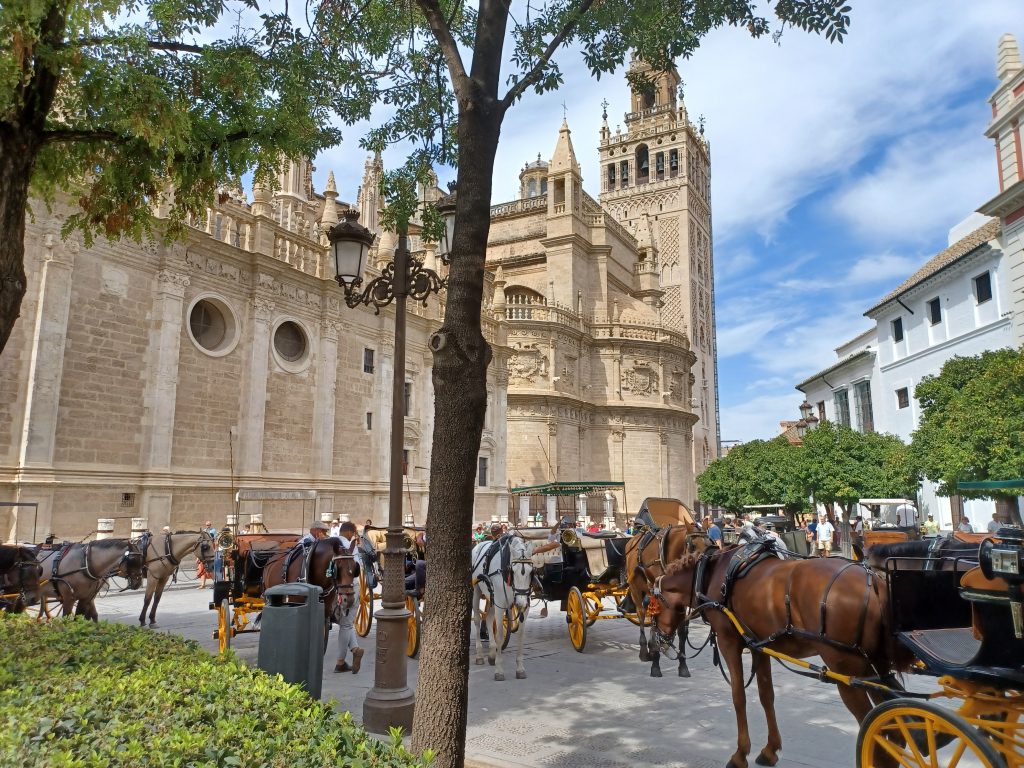
We wait in line between ropes and stanchions reminiscent of the airport queue. The sun beats down and time passes. Something to be said for booking online in advance, as I observe one or two persons dodging the line, gazing pitifully at the rest of us. But we arrive eventually at the entrance and pay our dues. The Catedral de Santa Maria de la Sede, Saint Mary of the See, is immense and was declared a UNESCO world heritage site in 1987. Originally the great mosque of the Moorish capital was located here, built in the twelfth century by the Almohads, but after the reconquest of the Muslims by the Christians in 1248 a church was built inside. Enlarged and altered in the centuries following, it is now the largest Gothic cathedral in the world.
The mosque’s minaret was modelled on the Koutoubia mosque in Marrakech, Morocco. Considered too lovely to destroy, it was transformed into the bell tower, known as the Giralda – so called because the bronze weather vane, in the shape of a woman, turns around on the top of it. ‘Girar’ means ‘to gyrate’. In fact there is a copy of the weather vane in the Cathedral courtyard, which we were able to observe keenly while we waited in the queue. The Giralda is 105 metres high.
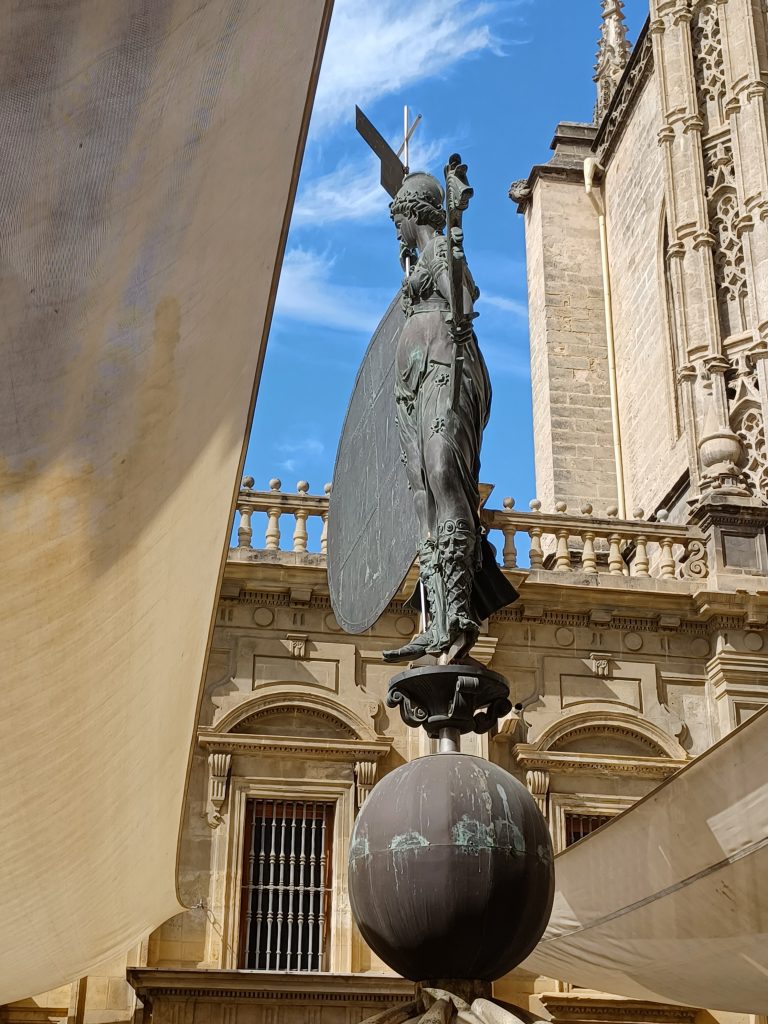
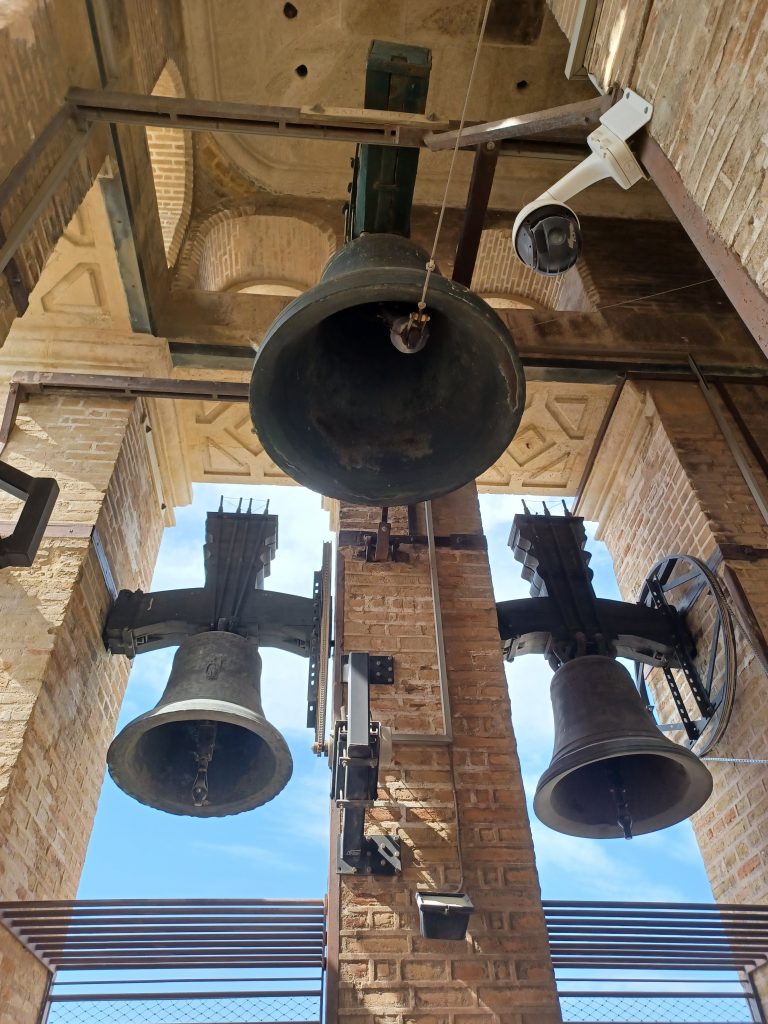
My plan first is to head up into the belfry. The original minaret had ramps built all the way up to enable the muezzin to ascend on a mule to call the faithful to prayer five times a day. They are still in situ. As I ascend I notice numbers on the walls above each ramp. I also note that older visitors are advised not to climb up if they suffer from any particular ailments, such as weak heart or breathing issues. I don’t. The last ramp is numbered 34, which is followed by some steep steps. There are grand views of Seville from each side of the belfry, albeit through sturdy grilles and people taking photos. The bells hang high above us.
One of the main sites to see in the cathedral is the tomb of Columbus. 1492 is the date when he discovered the Americas, some 500 years after the Vikings. Apparently his bones have been moved four times before settling here, although there seems to be some debate as to whether they are all, or any of, his remains or not. A herald stands at each corner holding up the tomb. They are supposed to represent the former four kingdoms of Spain – as are the bridges in the Plaza España – Navarre, Castille, Leon and Aragon. Quite splendid.
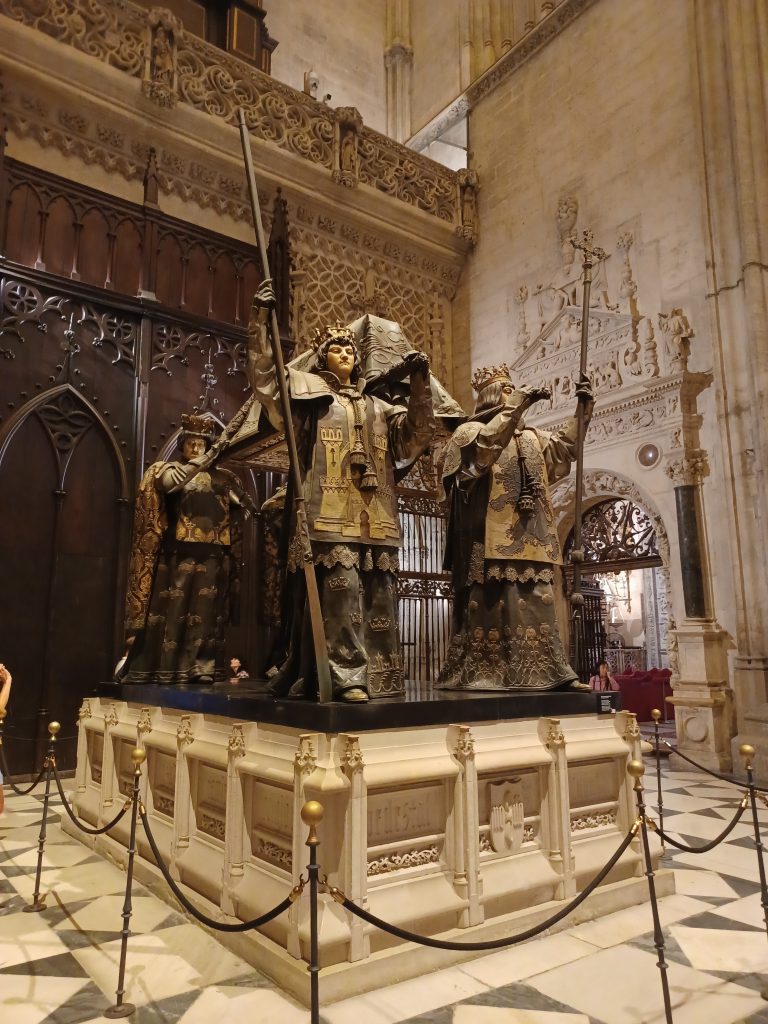
There are no less than eighty chapels in the Cathedral. One chapel dedicated to Santa Maria de la Antigua is, a sign tells us, where some of the conquistadors came to pray for protection before going off on their ‘expeditions’ in the Americas. The Cathedral is full of treasures, including some major artworks, such as the painting by Goya of the Saints Justa and Rufina; the Royal tombs, which feature, among others, King Fernando III in a silver urn. He, it was, who reclaimed Seville from the Moors in 1248. There are fortunes in works of gold and silver, huge gilt covered wood carvings, fantastic vaults and floors. No doubt enabled by Seville’s monopoly on trade with the New World in 1503. Far too much magnificence to describe here. Best go there and see for yourself. I exit via the ancient Patio de los Naranjos (Courtyard of Oranges), the onetime place of ritual cleansing by the Moors.
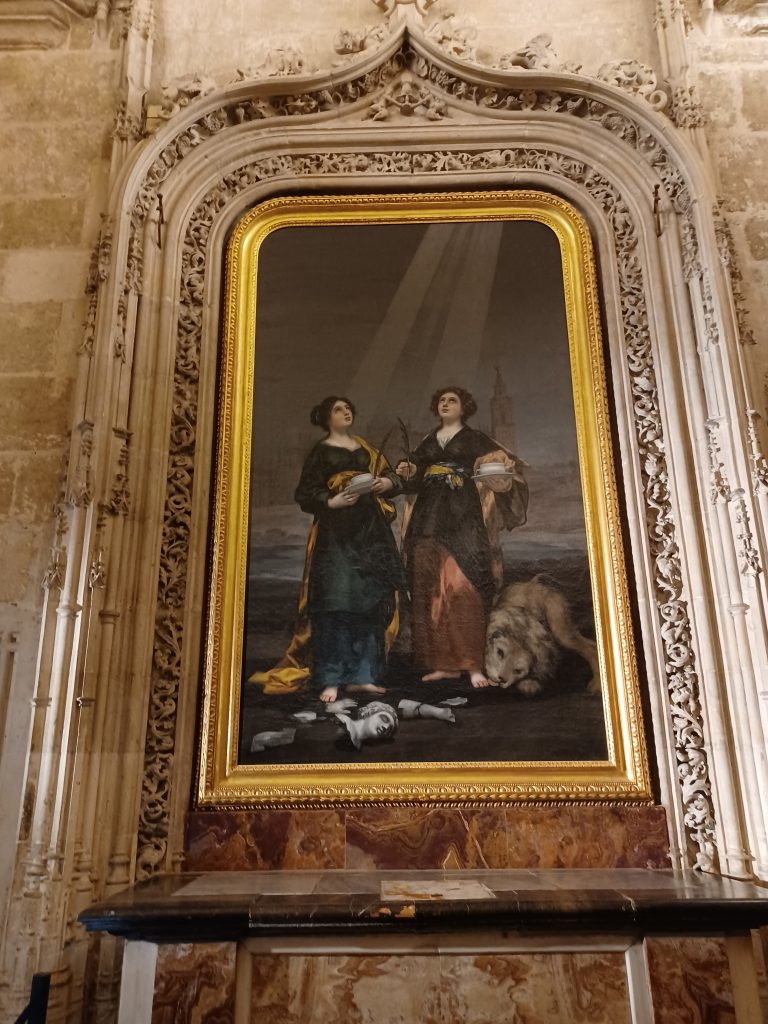
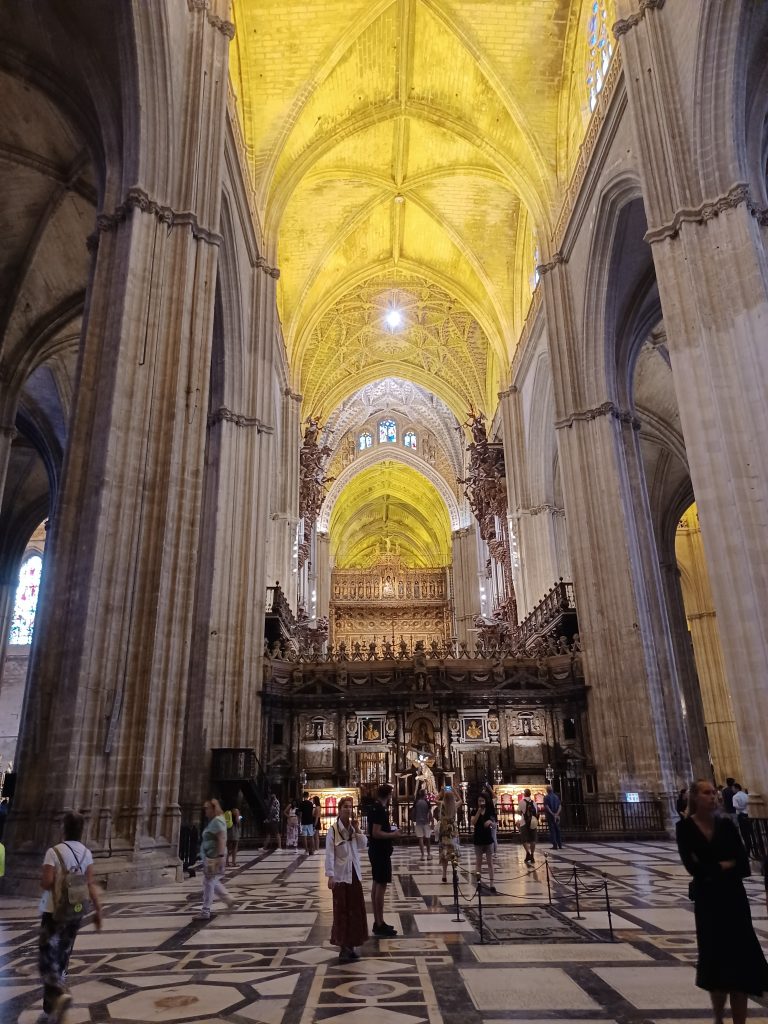
Flamenco
There is a flamenco show this evening. After more sizeable portions at dinner, we are bussed to the theatre, passing Seville’s famous bullring – no time to visit – and crossing one of the Guadalquivir’s bridges, to where the famous Emilio Ramírez dances every night of the year except for two. The little theatre is packed with eager spectators, each with a glass of some liquid refreshment, ordered beforehand as part of the price. I sip my sangria, while Emilio, with two male singers, a guitarist and a cast of several other male and female dancers, struts and stamps and quivers upon the stage. The women swirl their long colourful dresses and tap their feet crazily in the purplish light. There is much hand clapping and castanets and wailing, reminiscent of the muezzin’s call to prayer.
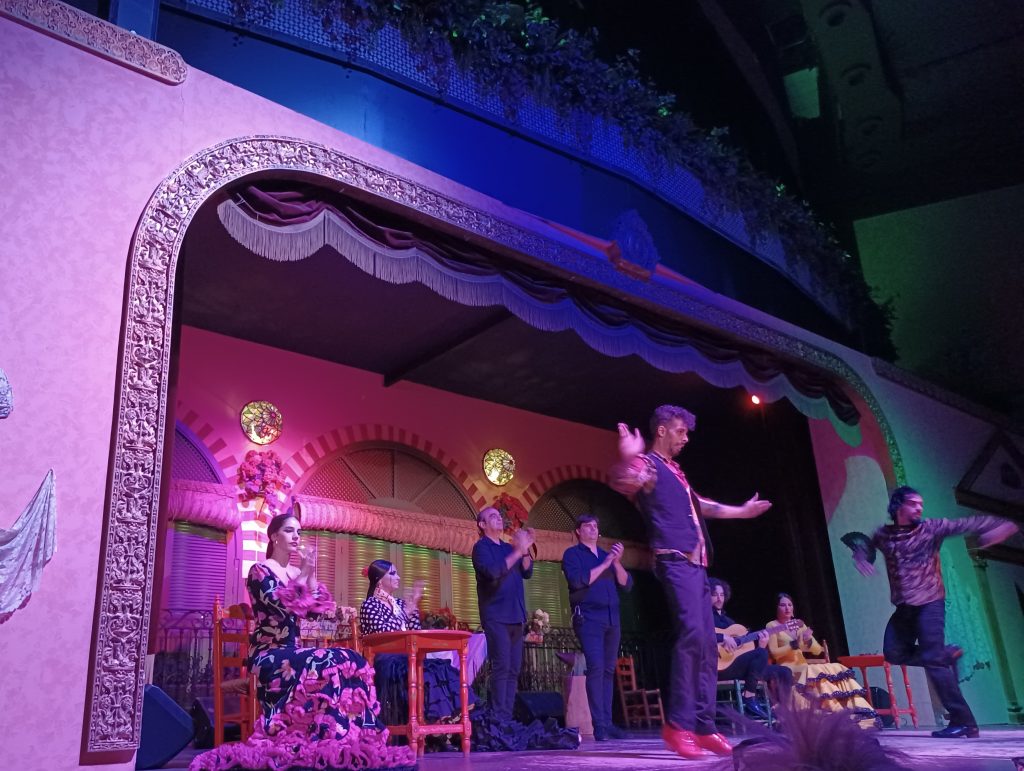

Leave a Reply